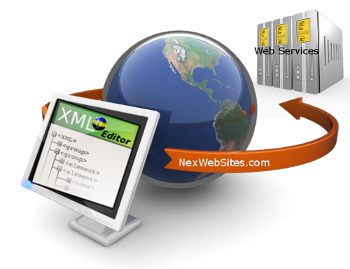
Web Services = XML + HTTP
Web services utilizing XML provide a method of exchanging data between different platforms and programming languages, while maintaining data integrity and the ability to express complex messages and functions.
Web services use XML to code and to decode data, and SOAP(Simple Object Access Protocol) to transport it (using open protocols). The HTTP protocol is the most used Internet protocol.
For Web services, interoperability is the highest priority.
What are Web Services?
- Web services are Web application components
- Web services communicate using open protocols like SOAP (Simple Object Access Protocol)
- Web services are self-contained and self-describing using WSDL (Web Services Description Language)
- Web services can be discovered using UDDI (Universal Description, Discovery and Integration)
- Web services can be used by other applications
- XML is the basis for Web services
Web Services take Web applications to the Next Level
Web applications are Web based software applications that can be used by any browser on any platform, which enable different applications on different platforms to work together.
By using Web services, your application can publish it's function or message to the entire world, as well as share data with other remote applications.
Web service interfaces and standards enable the interaction of common application functions such as billing systems or credit check approval processes, freeing companies to focus on the value-added elements of their core applications. With Web services, your product's database application on a Windows server can connect with your supplier's UNIX server to provide updated product information and pricing.
Web services are applications that exist on a network. A Web services' only function is to service specific requests from clients. These clients are other applications and other Web services. For example, when you are looking to find travel information for your vacation, you would browse a travel web site. Behind the scenes the the travel website's application will query a web service, which will provide flight details, rather than accessing proprietary data in a database, The only function this flight information web service does, is respond to requests for flight information from travel web sites. Web services are able to publicize their existence and communicate with web sites, and other web services, in an open, public, format. The travel web site software will access different web services for flight, accommodation and weather information.
Because web services exist on the Internet, and because web services communicate in standard, published, protocols, any client application can access and can communicate with Web services. If you're running a conference and want people to visit, you can have a 'fly here' page on your web page. With 5 minutes worth of coding, you'll be able to let people view flight availability to your conference and book flights online, without leaving your site.
Web Services and XML enable software developers to realize the dream of standardization
The proliferation of XML based Web services standards and development enables software interaction on a wide scale.
Web services prevail as the dominant system-to-system integration mechanism because they are based on the Internet, Internet standards and affords a higher level of abstraction to developers through XML.
Web Services have Two Types of Uses
- Web Services provide reusable application components.Web services can provide a vast array of application components like: currency conversion, weather reports, language translation as services and much more.
- Web Services connect existing software. Web services can help to solve the interoperability problem by giving different applications a way to link their data. With Web services you can exchange data between different applications and different platforms.
Web services platform elements include:
- SOAP (Simple Object Access Protocol)
- UDDI (Universal Description, Discovery and Integration)
- WSDL (Web Services Description Language)
What is SOAP (Simple Object Access Protocol)?
SOAP is an XML-based protocol that enables web applications to exchange information over HTTP.
SOAP is a protocol for accessing Web Services.
- SOAP is a communication protocol
- SOAP is a format for sending messages
- SOAP is designed to communicate via Internet
- SOAP is platform independent
- SOAP is language independent
- SOAP is based on XML
- SOAP is simple and extensible
- SOAP allows you to get around firewalls
- SOAP is a W3C standard
What is WSDL (Web Services Description Language)?
WSDL is an XML-based language for locating and describing Web services.
- WSDL is based on XML
- WSDL is used to describe Web services
- WSDL is used to locate Web services
- WSDL is a W3C standard
What is UDDI (Universal Description, Discovery and Integration)?
UDDI is a directory service where companies can register and search for Web services.
- UDDI is a directory for storing information about web services
- UDDI is a directory of web service interfaces described by WSDL
- UDDI communicates via SOAP
- UDDI is built into the Microsoft .NET platform
With ASP.NET, you do not have to write your own WSDL and SOAP documents, ASP.NET automatically creates WSDL and SOAP requests.
XML Database Design
Please contact us to learn more about implementing the powerful functionality of Web services for your custom web design or web development.
Sharing is caring:
WEBSITE-DEVELOPMENT
web development web services xml